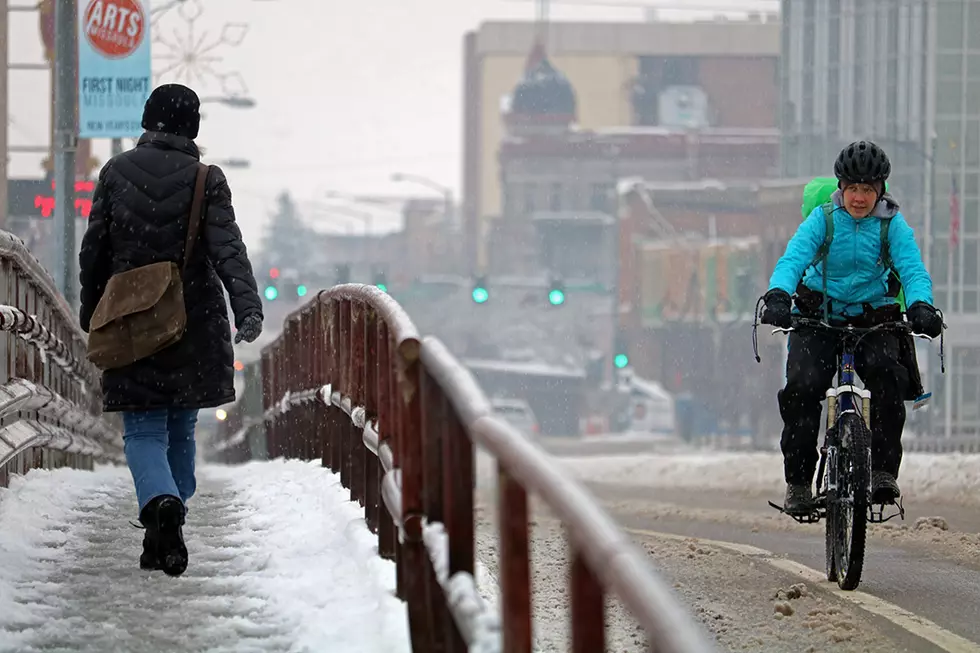
Winter commutes dangerous for Missoula bicyclists; city boosts plowing
Last winter, on a snowy morning in Missoula, Olivia DeJohn set out in her usual outfit: a dress, fleece-lined leggings, a coat, boots, mittens, wool hat and helmet.
Her studded tires gripped the road, and as the asphalt turned to snow, she gently steered her handlebars and pedaled out of the bike lane into the driving lane – there was nowhere else for her to go.
Within minutes, a car sped past her while the young male passenger yelled at DeJohn as he hung out the window. Then, he high-fived the driver.
“It was like they had to let me know I was slowing down their commute,” DeJohn said.
A committed year-round bike commuter since 2016, DeJohn said hers isn't an unusual story.
“In general, people are more aggressive about cyclists in the winter,” she said. “To make a point, they speed by really fast on icy roads.”
Missoula has a reputation as a bikeable city, and many Missoulians commute by bike, even during the winter months. But snowy weather and challenging road conditions often make winter bike commuting tricky.
To improve road conditions, the city’s FY 2020 budget includes an additional $154,000 for snow plowing. The increased funding will support improved equipment and additional operators.
Snow removal is managed by the City Streets Division. The superintendent, Brian Hensel, said the budget increase came after a 2018 Citizen Survey that revealed 34 percent of residents were dissatisfied with snow removal.
The new budget will afford the city three new trucks with plows and four more operators.
Hensel said this funding will create better service to residential streets, which historically have been a lower priority for the city. Residential streets tend to become deeply rutted and frozen after snow falls, and plows aren’t able to do anything once the ruts freeze. If plows can get to residential streets sooner, they can mitigate the problem.
The increase in manpower should help winter cyclists navigate residential streets, but plowing in bike lanes will remain the same, said Hensel. He hopes better plowing on residential streets will help cyclists get to bike lanes on priority streets.
“I think we will see an improvement,” Hensel said. “I’m sure riding a bicycle in ruts is not easy.”
Missoula in Motion, a city program that encourages sustainable transportation, said bikers in Missoula commute all year, even on cold winter days. The program facilitates bike counts several times a year and encourages cyclists to get out on Winter Clean Commute Day in February.
Even with a lot of enthusiasm surrounding winter bike commuting, Jon Sand, program assistant, said they get significant feedback from winter cyclists with concerns about winter shoveling and snow in bike lanes.
He is optimistic about the new snowplowing budget, hoping it will help keep bike lanes clear and improve access to residential streets. But “even with additional funding, some places will still be missed,” Sand said.
“Winter biking is an unpleasant experience 80% of the time,” said Zach Viente, who has biked year-round for seven years. He admits he is a little scarred from last winter: it was cold, brutal, and icy.
For Viente, figuring out his winter route is essential.
“Before they started plowing the bike paths, I had to figure out which neighborhoods got plowed and which didn’t,” he said, adding that he plans his route to avoid what the city calls priority streets. “It would be crazy to ride Broadway in the winter. On every major road, snow is plowed into the bike lane.”
In terms of the city's snow plowing efforts, Viente said, “they could do much better. Last year they plowed my street twice.”
Emily Jensen, program director at Free Cycles, relies on her bike to get around. She doesn’t own a car. While she admits the city does a great job at plowing its bike trails, she believes the bike lanes could use some work.
“People always think, you can just bike on the trail, but getting to the trail via bike lanes and roads isn’t always safe,” she said. “All of the snow gets pushed into the most dangerous spots in the bike lanes, forcing bikes into the driving lane.”
She feels that often, other forms of transportation get priority, and bikers get lost in priorities and maintenance. She believes winter cyclists shouldn’t feel like less of a priority just because they are a smaller demographic.
Caitlyn Lewis, executive director of Soil Cycle, a bike-powered compost collection company, has spent four years perfecting her gear for winter bike commuting. She’s also wrecked on snowy streets when trying to get out of cars’ way.
“The city assumes cyclists don't bike in the winter, and this doesn't coincide with the lifestyle they promote, such as sustainable transportation and renewable energy,” Lewis said. “Missoula has been suffering a lot of growing pains, and the (new snowplow budget) just meets the demand of a city in western Montana.”
Should snow plowing concerns be limited to cyclists? Eva Rocke, the sustainability coordinator for the University of Montana, said plowing goes beyond bike safety. It should be an issue for all alternative modes of transportation.
“If we aren't effectively plowing, this is critical for all abilities,” she said. “I have had to cross the street on foot and leap over a big pile of snow in the median. That is unacceptable.”
With elderly people on foot and individuals in wheelchairs, Rocke believes the city needs to maintain accessibility for all.
Touring along on her Bianchi steel-framed bike, DeJohn admits biking in the winter isn’t always fun, but she is optimistic. She believes the city, overall, is doing better.
“They seem to care about making the city more bikeable,” she said. “I want to bike on residential streets, and I will if they are plowed.”
